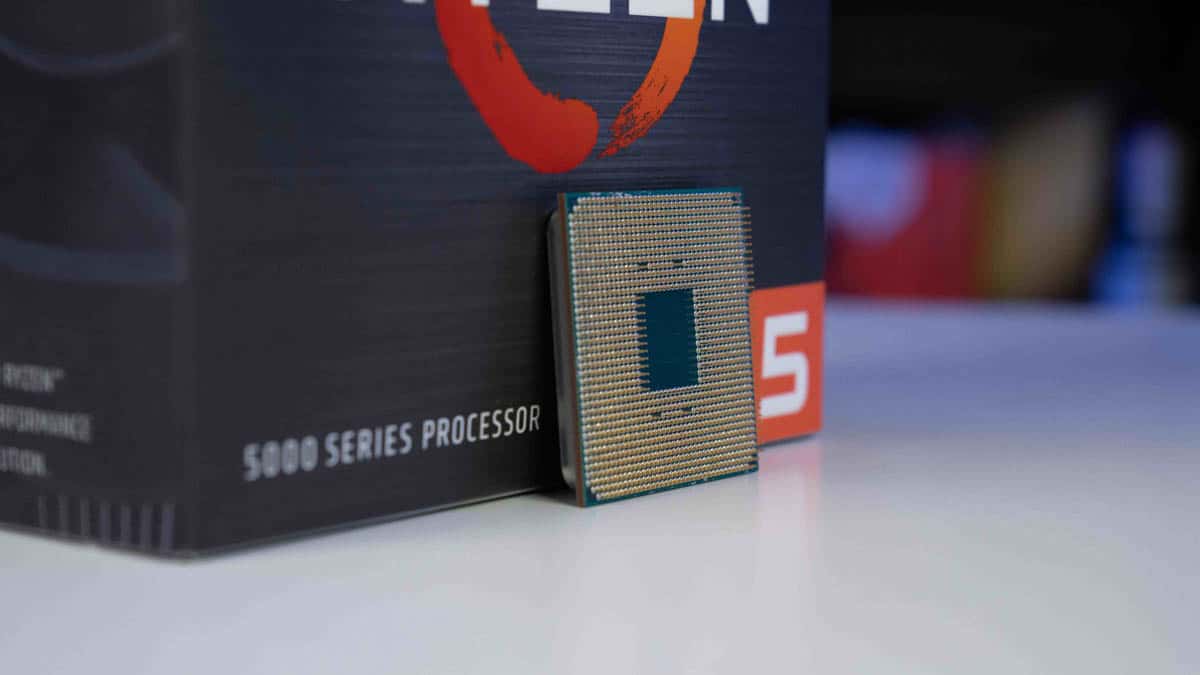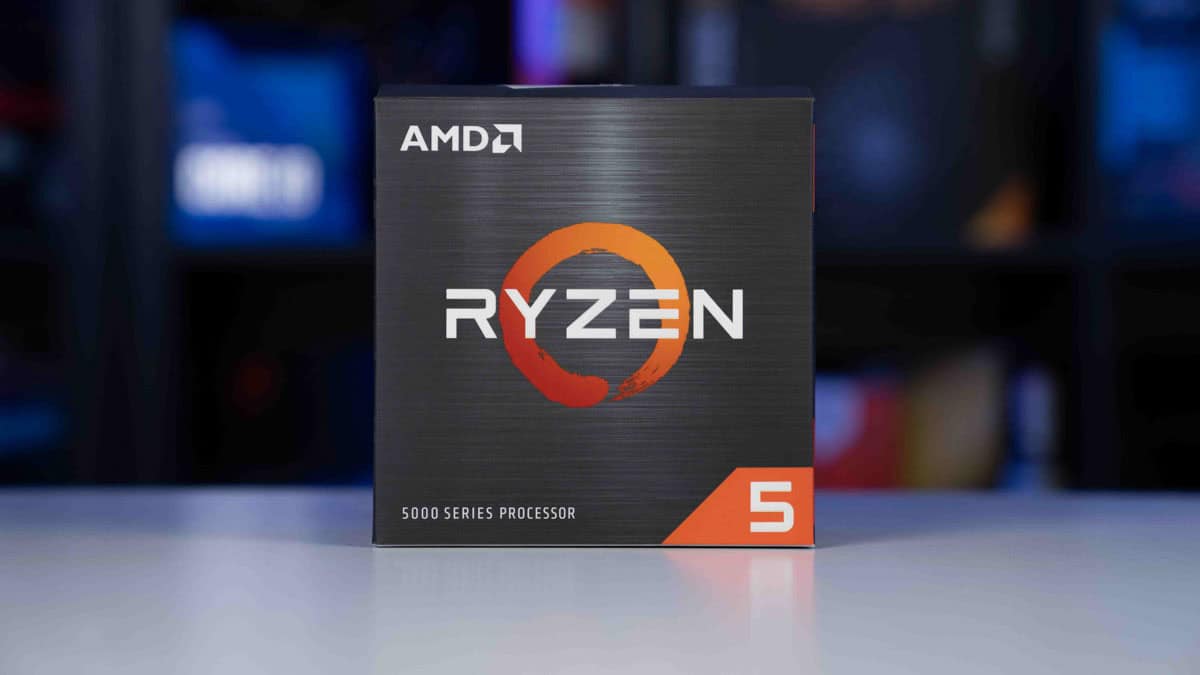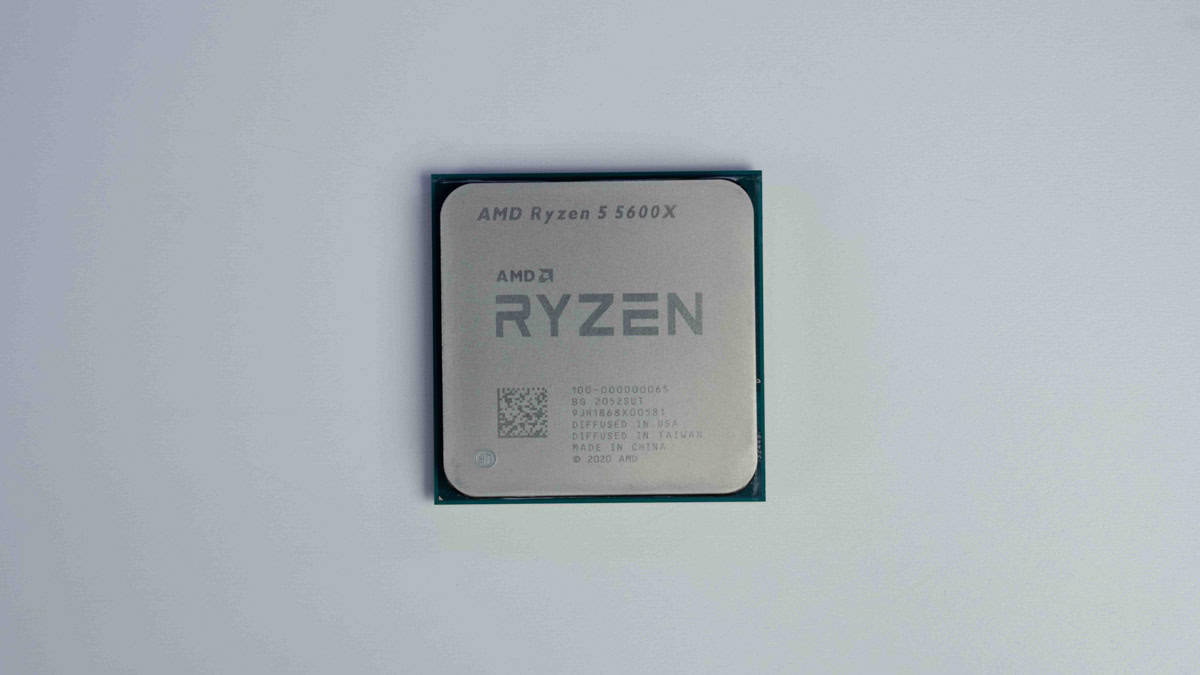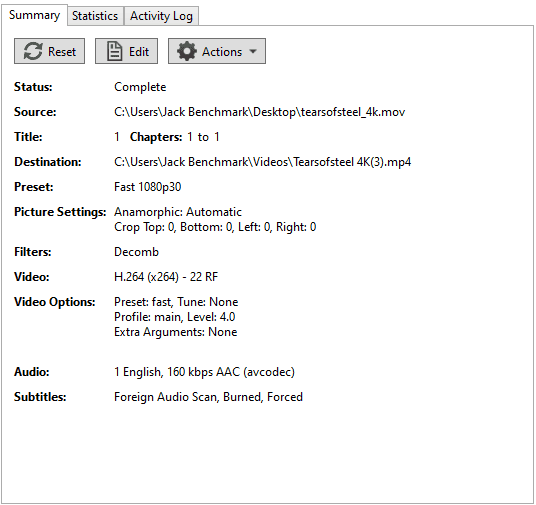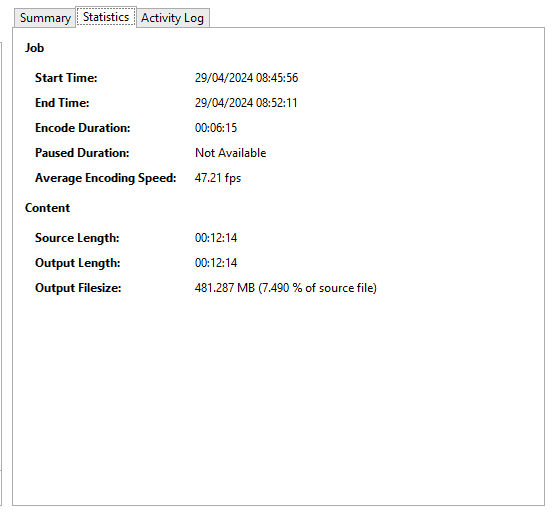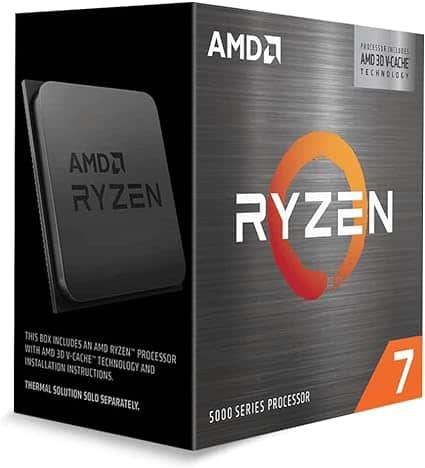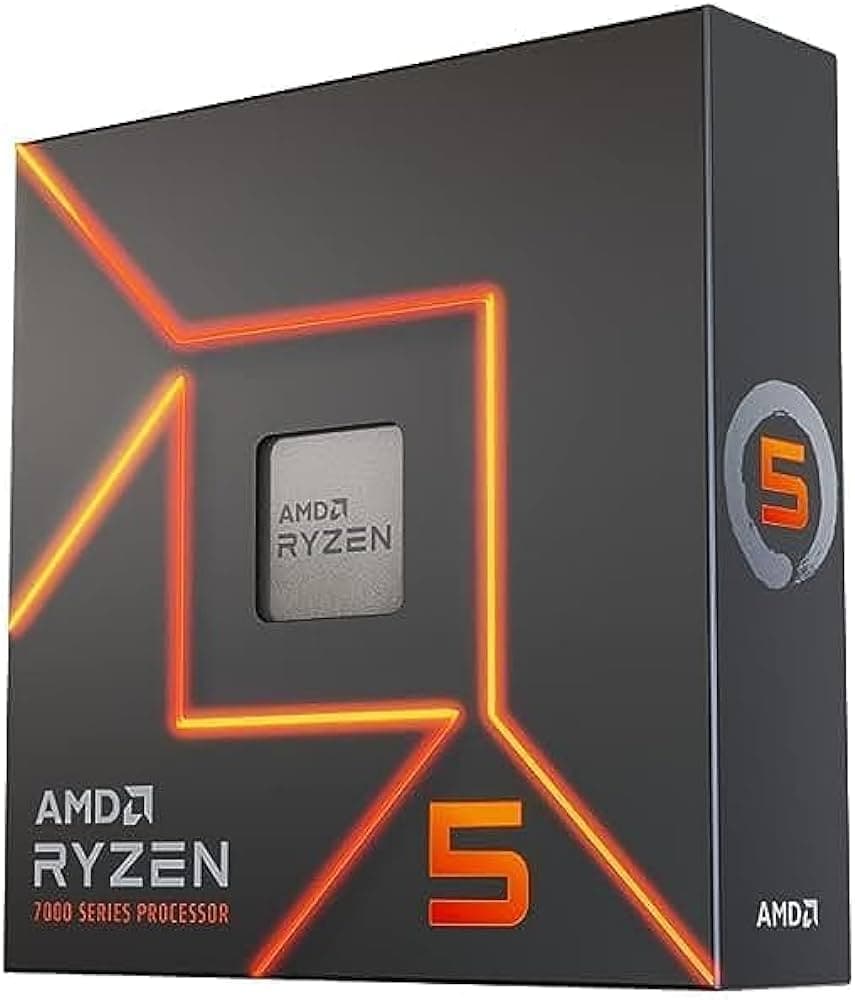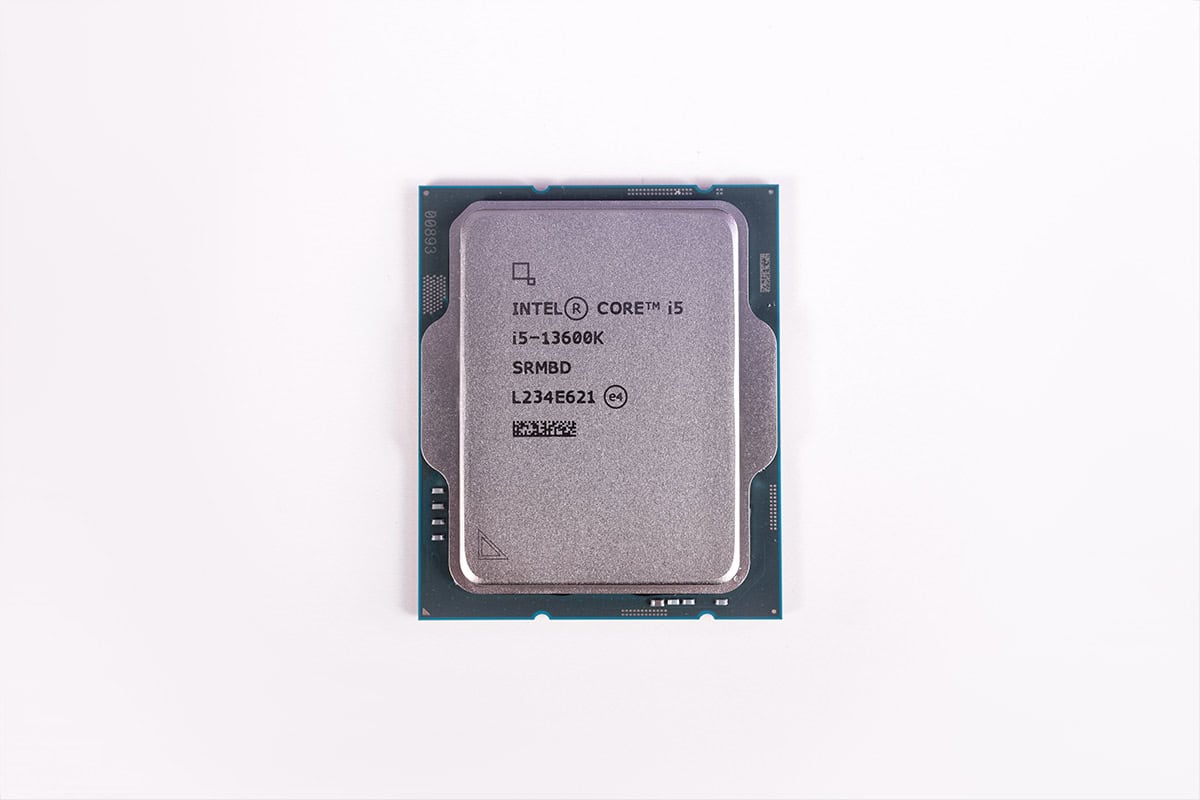AMD Ryzen 5 5600X review – is AM4 still worth it?
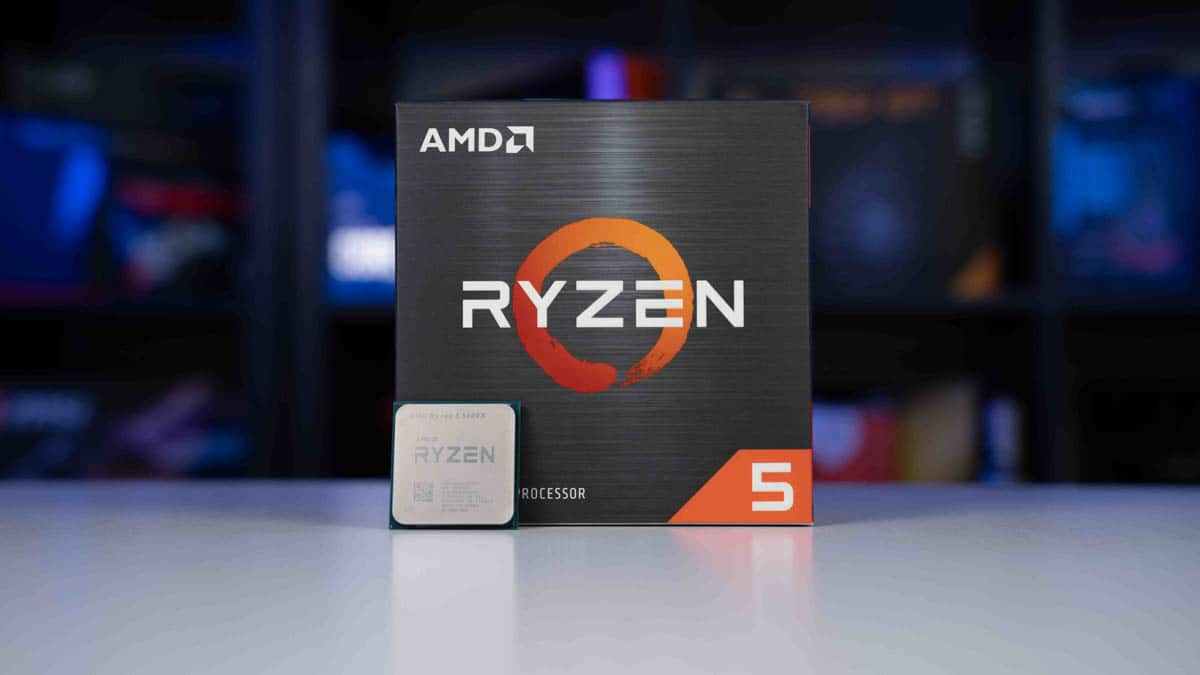
Table of Contents
The AMD Ryzen 5 5600X has to be one of the best CPUs ever made, sorry to spoil the review like that, but it’s just how it is. This Ryzen 5 was released as part of the 5000 series back in November 2020, and it still leaves an impression today. Here’s our AMD Ryzen 5 5600X review, we’re going to explore the performance of this budget beast, and understand what makes this CPU one of the greats.
Our CPU may still be on AM4 and aging just a little, but we’d call that a strength in this case, not a weakness. This little 6-core CPU can do far more than you think with what it has – the best part is, it’ll cost you hardly anything to experience what the 5600X has to offer.

- Cores: 6
- Threads : 12
- Boost speed : up to 4.6 GHz
- Base speed: 3.7 GHz
- L3 Cache: 32 MB
- TDP: 65W
- Platform: AMD (AM4)
The 5600X is a strong and very affordable budget CPU despite being released in 2020. It belongs to one of the best platforms ever made that remains in support today despite the release and success of AM5.
- Incredible price to performance ratio
- Included boxed stock cooler
- Plenty of supporting motherboards to choose from
- readily available both second hand and brand new
- Efficient – Only a 65W TDP
- Not as powerful as current gen
- Locking yourself into AM4
- Not the best for heavy multi-core workloads
Why we gave it a 4.5
The Ryzen 5 5600X is one of the best value driven CPUs on the market. If you don’t mind being behind in the storage speed department, you can save a lot of money opting for AM4 over AM5 or LGA 1700. The 5600X brings efficiency and cost effectiveness like we’ve never seen in 2025.
To cut this long review short, if you’re looking for an incredible, affordable CPU that can handle most gaming workloads, then the 5600X might just be for you. If you’re planning on doing a lot of intensive multi-core tasks, then you’ll be better off opting for one of the other 5000 series that offer a few more cores to play with. That’s if you have your heart set on AM4 in the first place. I don’t see it falling out of favor for at least another 2 years.
CPU Specifications

It’s nice to get a little rundown of system specifications, however, we need to take a more in-depth look at this CPU to see what makes it tick. – get it, clock speed, never mind.
Here’s what the 5600X offers us in terms of specifications:
- Cores: 6
- Threads: 12
- Base clock speed: 3.7GHz
- Boost clock speed: 4.6GHz
- L2 Cache: 3MB
- L3 Cache: 32MB
- TDP: 65W
- Socket: AM4
As you can see, the Ryzen 5 CPU looks like any other, the clock speed is a little lacking compared to Zen 4, but that’s where technology was back then. Zen 4 made many improvements over Zen 3, but there’s one thing that the newer generation couldn’t take away. And that is its character.
IPC is something that comes into play when looking at the specifications of a CPU. It’s the hidden metric that can be just as important when deducing CPU performance as core speed or number of cores. We’re not going to get too far into IPC here, but if you want to know more, you can check out the review of the 7900X we did. There’s loads of information in there about IPC.
Performance
Before we jump into the benchmarks, we have to note the rig on which we tested the CPU. This is because the rig we used directly contributed to the results that we got, your results may vary unless you have the same rig as us, which is unlikely.
Here are the components that comprised our Ryzen 5 testing rig:
| Component | Name |
| GPU | RTX 4070 Ti Super |
| Memory | Netac Shadow DDR4 @ 3200MHz |
| Motherboard | Gigabyte Aorus Pro X570 |
| CPU cooler | Corsair Elite LCD Capellix 360MM |
| Power supply | ASUS ROG Thor 1000W |
| Case | Cooler Master Masterframe |
We must keep the components as close as possible to each other, even when testing generationally. It’s difficult when the memory is twice as fast on newer generations, but we do what we can.
Synthetic benchmarks
Time to get into the nitty-gritty of how our Ryzen 5 performs. We tested our AMD CPU in many scenarios that should encompass the capabilities of the CPU as a whole. Some of the benchmark programs we used include Cinebench, Geekbench, 7-Zip, and Puget systems. We like to include more productivity-heavy benchmarks here on PCGuide, we know that everyone likes to game, but you PCG viewers just like to get things done.
With that being said, let’s get onto the results.
| Benchmark | Score |
| CPU Z Single | 641 points |
| CPU Z Multi | 4,927 points |
| Cinebench R23 Single | 1,419 points |
| Cinebench R23 Multi | 11,151 points |
| Geekbench Single | 2,138 points |
| Geekbench Multi | 8,456 points |
| Puget Systems photoshop | 6,087 points |
| Blender render | Monster 69.03 SPM Junkshop 48.04 SPM Classroom 35.27 SPM |
| 7 Zip Compression 32MB (10 passes) | 59.50s |
| Handbrake TOS 4K Fast 1080P encode | Average Speed 47.21 FPS Encode Time 06:15 |
We have quite the benchmark suite that gives us a comprehensive picture as to how this CPU performs outside of gaming, and spoiler alert, it does well for what it is. Let us explain.
CPU-Z
CPU-Z is a long-standing staple in the CPU benchmarking space and we use it to get a baseline of all the CPUs we test. We do this because there are a lot of benchmarks available for CPU-Z. Surprisingly, our CPU manages to beat out the single-core performance of the 5700X slightly, by 1 point. In reality, the cores are pretty much the same, it is just interesting to know that you’re getting the same cores in the 5700X, just more of them. If you want to compare our CPU to others, you can use the Cinebench database. Just note that the scores are stacked against you.
These are the best of the best
Cinebench scores in the database are verified averages of best scores, they don’t represent the typical score you’re going to see on a standard system. So if it looks like your CPU is underperforming slightly, it probably isnt. An average system probably isn’t going to do quite as well as you see on the scores.
Cinebench
Cinebench takes the rendering power of your CPU and makes a table and a set of chairs out of it, seriously. This render is complex and very information-dense so naturally, we use this to measure CPU compute power. The 5600X performed close to the 5700X in terms of single-core performance again, but it was beaten in the multi-core, as it has less to work with.
Geekbench
Geekbench does pretty much everything you could ask of a CPU benchmarking tool, it measures everything from compression to machine learning. Our CPU scored decently in Geekbench, managing 2,138 and 8,456 points respectively. Once again, there is a Geekbench database you can use to weigh this CPU against what you have, this will help you see the performance improvements you might expect from this upgrade.
Puget Systems Photoshop

Puget Systems Photoshop is like the final boss of photo editing benchmarks, this test outs your CPU through the wringer when it comes to editing photos. Puget tests your CPU on things like opening large RAW files, compressing them, applying filters and effects, you name it, it does it. It also makes 3 passes. When all was said and done, the 5600X scored 6,087. Which is again close to its Ryzen 7 brother which has 2 more cores at its disposal.
If you’re interested in Photo editing, we suggest you check out the full benchmark
The Puget Systems benchmark is incredibly complex, and it really pushes CPUs to their breaking point when it comes to rendering images and applying complex filters, if you’re interested in getting a CPU for photo or video editing, it’s recommended that you give the results a look over.
Blender

We use the handy Blender benchmark to deduce how well a CPU performs when rendering complex 3D spaces. the benchmark includes 3 increasingly more complex scenes, but we use Monster, the least complex of the three as a baseline. When you compare the score of our Ryzen to say a 7900X, it doesn’t look that impressive, the 7900X manages 184 points in monster. But having said that we don’t typically use CPUs for rendering images.
That job usually falls to the GPU, as they are great at linear instructions, which rendering is, and it’s exactly what a GPU was made for. To put it into perspective, the 4070 Ti super that we use to test the CPUs gets around 3726 points in Monster.
7-Zip compression test
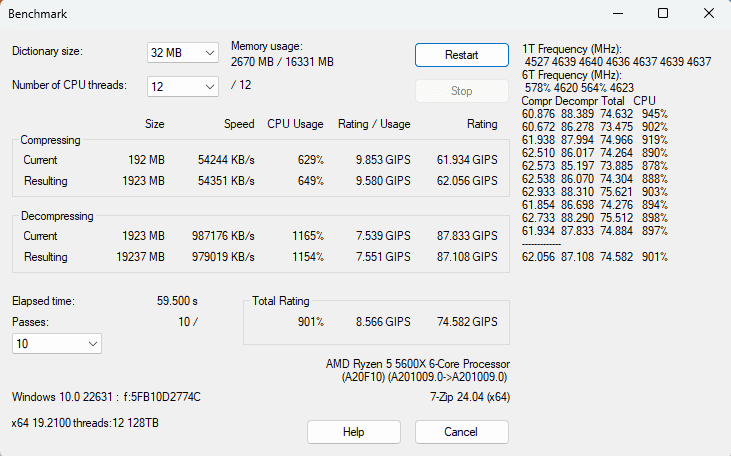
You’ve probably heard of 7-Zip, it’s one of the most popular compression and archive extraction tools. It’s probably the best Zip tool in an alternate dimension where WinRar wasn’t invented. this test takes a 32MB package and cycles between compression and decompression, it does this 10 times. The faster it does this, the better the CPU is. Our Ryzen CPU managed all these passes in just under 1 minute. If we compare that to the 7900X, the 5600X was only 10 seconds slower but is less than half the price.
Handbrake Tears of Steel 4k encode
Since we included photo editing proficiency tests, it’s only right that we get some Video ones in there. A handbrake is a video encoder that measures a CPUs ability to, well, encode video. There is a standard test known as Tears of Steel, where a short 4K video is encoded using a standard preset and measured.
We used the 1080P fast preset to encode the 6GN 4K video and our CPU managed to get everything done in 06:15 with an average encoding speed of 47.21 FPS.
Real-world benchmarks
We had to test the Ryzen CPU we had in gaming workloads, this is because many people now choose to work and play on the same system, and who’s going to avoid the chance to play games at work? Not me.
We tested the 5600X in 2 games, Days Gone and Cyberpunk 2077, both of these games have had their moments in terms of performance issues. So it’s cool to see how certain CPUs stack up against these games. bear in mind that a lot of gaming performance comes from the GPU, we test all of our games in 1080p low settings to ensure we’re not GPU-bound. Here are the results of our game testing.
| Game | Result |
| Days Gone | 177 FPS / 1% 67 FPS |
| Cyberpunk 2077 | 282 FPS / 1% 133 FPS |
As you can see, our Ryzen 5 struggled a little in Days Gone compared to some of the other CPUs that we tested, but Cyberpunk’s performance remains similar.
Days Gone
Days Gone can be a hard game to run at times, and the 5600X proved that, while the score is a little lower than expected, there were little to no noticeable stutters, and the game felt buttery smooth at 177 FPS. With that being said, if you wanted an AM4 gaming processor, you should probably opt for the 5800X3D.
Cyberpunk 2077
Cyberpunk has had more than its fair share of teething problems, but it is getting better with every update. Our Ryzen CPU manages to sustain levels of performance on par with even some of the next-generation CPUs we have tested. This might suggest a GPU bottleneck but it’s still good to know that the 5600X can handle 282 FPS averages without breaking a sweat. The game as always ran smoothly with no noticeable stutters.
What do these benchmarks mean?
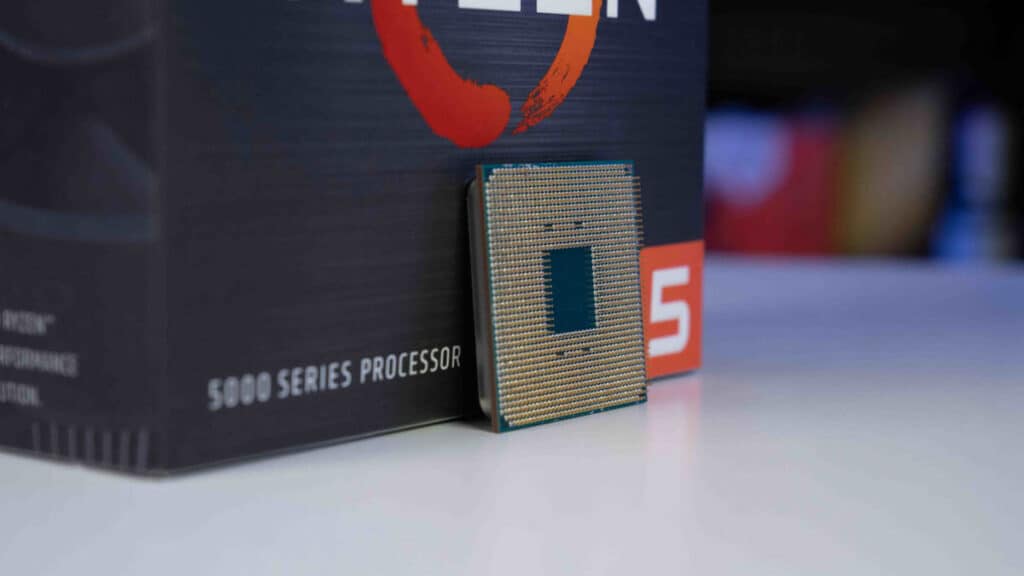
We use the synthetic benchmarks to try and simulate as many workloads as possible. Not everyone uses CPUs for the same reason, and no one test encompasses all use cases. These tests are designed to test a CPUs ability to perform productivity tasks, such as video editing, photo editing, simulation, or rendering. Because these loads are not gaming workloads, we test them in a controlled synthetic environment where we can get the best repeatable results. If a CPU scores well in these benchmarks compared to the CPU you currently have, then it will be a good upgrade.
The world, on the other hand, is essentially gaming workloads. The issue with real-world benchmarks is repeatability, when you’re testing a game, you likely can’t do the same thing every time, you’re not a robot. Thi sis exactly where synthetic benchmarks win. However, you need to get out there and test the gaming performance of CPUs. Nobody is all work and no play.
Price
The CPU we have in our crosshairs today retailed back in 2020 for $299, even by today’s standards that’s not bad. However, this CPU is available for much less now if you know where to look, $142 is the price on Amazon as of the time of writing. Price tracker, Camelcamelcamel, suggests that the lowest price this CPU has ever been on Amazon is $122. You could always shop on the second-hand market if you want an even better deal.
Alternatives to the Ryzen 5 5600X
-
AMD Ryzen 7 5800X3D
- Cores: 8
- Threads: 16
- Boost speed : Up to 4.5 GHz
- Base speed: 3.4 GHz
- L3 Cache: 96 MB
- TDP: 105W
-
AMD Ryzen 5 7600X
- Cores: 6
- Threads : 12
- Boost clock speed: 5.3 GHz
- Base clock speed: 4.7 GHz
- L3 Cache: 32 MB
- TDP: 105W
-
Intel Core i5-13600K
- Cores: 14 (6P-8E)
- Threads: 20
- Boost speed : P-Core 5.1GHz / E-Core 3.5GHz
- Base speed: P-Core 3.5GHz / E-Core 2.6GHz
- L3 Cache: 24MB
- TDP: 181W
If you’re after another AM4 CPU with more of a focus on gaming, then you can’t go wrong with the Ryzen 7 5800X3D. This CPU managed to beat the 12900KS in some gaming workloads, which is a revolutionary feat and a massive win for 3D V-cache. Having said that, the productivity and multi-core performance do suffer as a result so choose this only if you plan on gaming primarily.
The 7600X is more to bring the system back into modern times, with all the value and performance that the 5600X brings, just on the platform that allows for all the features that AM4 misses.
The 13600K is for those who are stuck with an LGA 1700 motherboard, or just want to see what Team Blue tastes like. The 13600K is a fantastic, high-power, and efficient alternative to this CPU, and it will beat it in almost any scenario. Couple that with the advantages of being on the “next-gen platform” and you have yourself a winner.
Is AM4 still viable in 2025?
Yes, AMD just released the AMD 7 5700X3D on the AM4 platform, showing that it is very much still in support. AM4 was leading the charge in terms of the best platforms to be on for around 6 years before AM5 was released, and it’s still going strong today. Whilst Intel was changing its socket for every other CPU, AMD was staying the course on one socket, meaning with a few BIOS updates, you could have gone all the way from 1st to 3rd gen Ryzen on the same motherboard if you wanted to.
But what does that mean for AM4 now? Well, AM4 is pretty limited in what it can do now. You don’t have access to PCIe Gen 5 on GPU or storage, and you don’t get some of the newer wifi features such as Wifi 7, and many lack Thunderbolt connectivity. But these might be of no use to you, in that case, you can save a lot of money by opting for AM4 over AM5. It will harm the future-proofing of your system, however.
Summary

- Cores: 6
- Threads : 12
- Boost speed : up to 4.6 GHz
- Base speed: 3.7 GHz
- L3 Cache: 32 MB
- TDP: 65W
- Platform: AMD (AM4)
The Ryzen 5 5600X is a fantastic budget CPU that can bring you a lot of power if you don’t need the cutting edge in your system. The 6 cores and 12 threads make this a good CPU for light productivity work and a bit of gaming, and all for around $140 is a steal. You have to bear in mind, however, that the day will eventually come when you have to upgrade to AM5 just to stay relevant, and that upgrade may be costly depending on when you do it.
This CPU can keep up with gaming and productivity workloads, as long as you’re not trying to run some NASA-level calculations. If you need something a little faster on the AM4 platform, you can always opt for a 5900X. AM4 should still be in support for a couple of years yet.

